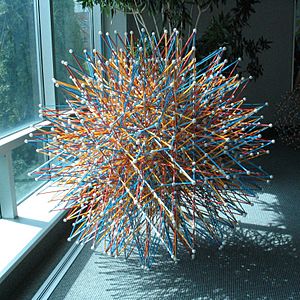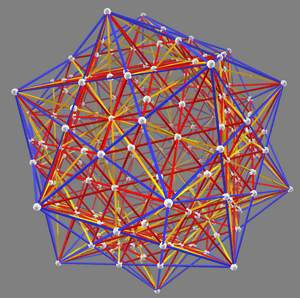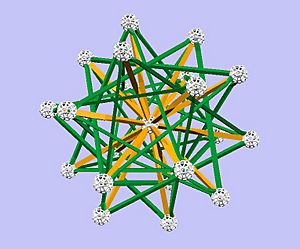Zome facts for kids
The word zome describes a few related things. First, a zome is a special kind of building. These buildings use unusual shapes, very different from the normal square or rectangular houses we usually see.
The word "zome" was created in 1968 by Steve Durkee. He combined the words dome (like the top of a round building) and zonohedron (a type of geometric shape). One of the first zome models became a big climbing structure at the Lama Foundation.
Second, "Zometool" is a fun building toy. It's like a super advanced "ball and stick" construction set. Kids and adults both love it, and it's great for learning about geometry.
Finally, the "Zome system" refers to the math ideas behind how the Zometool toy and buildings are put together. Both the unique buildings and the learning toy were invented by Steve Baer, his wife Holly, and their friends.
Contents
What are Zome Buildings?
After studying math, Steve Baer became very interested in building new kinds of structures. He wanted to use special geometric shapes called polyhedra. In the 1960s, Steve and his wife Holly moved to Albuquerque, New Mexico.
There, he started building unusual structures. He called them "zomes," using his friend Steve Durkee's new word. These buildings were designed to fit their environment. They were also good at using solar energy from the sun. Baer was inspired by the dome shapes made popular by architect R. Buckminster Fuller. He wanted to make buildings that improved on some of Fuller's dome designs.
In recent years, builders in the Pyrenees mountains in France have started using the zome building style. These buildings have many different geometric lines. A book called Home Work (published in 2004) even showed some of these unique zome buildings. While many newer zomes use wood, Steve Baer's first designs often used metal frames with a metal outer skin.
Zomes are also used in art, sculptures, and even furniture. A company called Zomadic in San Francisco uses zome shapes to create artistic structures. These are often made from plywood cut by machines. The founder, Rob Bell, often brings his zome art to Burning Man, a big art event in Nevada.
Another inventor, Richie Duncan of Kodama Zomes, created a hanging zome system. These structures hang from a single point above. They are made of metal and fabric, and you can put them together and take them apart easily. This hanging zome system has been used for furniture, art shows, and even treehouses!
Yann Lipnick of Zomadic Concepts in France has studied zomes a lot. He has built many zomes using different materials. He believes zomes have a special, calming feeling. He even teaches classes and writes books about how to build them.
What is the Zometool Construction Set?
The Zometool is a plastic construction set. It's made by a company in Boulder, Colorado. This company grew out of Steve Baer's original company, ZomeWorks. You can think of it as a "space-frame construction set."
The set has two main parts: small connector nodes (the "balls") and struts (the "sticks") of different colors. The connector nodes look like a special geometric shape called a small rhombicosidodecahedron. But instead of flat faces, they have small holes. The ends of the struts fit perfectly into these holes. This lets you build all sorts of amazing shapes.
The idea to color-code the three types of struts came from Marc Pelletier and Paul Hildebrandt. They also invented a special mold with 62 hydraulic pins to create the connector nodes. The first perfect connector node came out of their mold on April 1, 1992. These parts are made from strong ABS plastic.
Since 1992, Zometool has added more products. They have mostly focused on making different styles and types of struts. The basic design of the connector node hasn't changed since 1992. This means all the new parts still work with the old ones.
From 1992 to 2000, Zometool kits came with connector nodes and blue, yellow, and red struts. In 2000, they added green lines. These were designed by a French architect named Fabien Vienne. They let you build shapes like the regular tetrahedron and octahedron. In 2003, Zometool changed the struts slightly. The new struts have a different texture and longer ends. This makes the connection between the node and strut stronger.
How Zometool Parts Work
The color of a Zometool strut tells you about its shape and which hole it fits into.
- Each blue strut has a rectangular cross-section (like a flat rectangle).
- Each yellow strut has a triangular cross-section.
- Each red strut has a pentagonal cross-section (like a five-sided shape).
- Green struts have a rhombus cross-section (like a diamond). They fit into the red pentagonal holes. Green struts were added later, so they are a bit different to use than the other colors.
You might find connector nodes in different colors, but they all work the same way.
The yellow and red struts have a slight twist in the middle. This twist makes sure that the connector nodes at each end of the strut face the same way. Blue struts have a non-square rectangular shape that also ensures the nodes line up. Green struts have two bends instead of a twist. This helps them fit into the pentagonal holes.
The word Zome also comes from the idea of "zones." The Zome system has up to 61 zones. These zones are like imaginary lines or directions that the struts follow. The colors of the struts match these zones.
- There are 15 blue zones.
- 10 yellow zones.
- 6 red zones.
- 30 green zones.
There are also "half-blue" struts, which are half the length of a regular blue strut. They used to be light blue. There are also "blue-green" struts. These fit in the same zones as green struts but have a different length ratio.
Zome for Modeling Shapes
The Zome system is really good for building models of complex geometric shapes. Especially shapes that have a lot of symmetry. These include the five Platonic solids (like cubes and pyramids). It's also great for modeling 4-dimensional shapes.
Here are some other cool math objects you can model with Zome:
- Some Kepler-Poinsot polyhedra (special star-like shapes).
- Shapes made by combining several regular polyhedra.
- Many 4-dimensional shapes.
- Different versions of the rhombic triacontahedron (a 30-sided shape).
- Many versions of the regular icosahedron (a 20-sided shape).
- Zonohedra (shapes made of parallelograms).
- Hypercubes (4D cubes) in many dimensions.
- Most uniform polyhedra (shapes with regular faces).
- Many uniform 4-polytopes (4D shapes with regular faces).
- Some Johnson solids (special convex polyhedra).
- Two of the Catalan solids (shapes with irregular faces).
Other Ways Zome is Used
Zome isn't just for pure math! People use it for other things too.
- Engineering: To study how steel structures work.
- Science: To model tiny structures like molecules, nanotubes, and viruses.
- Art: To create soap film surfaces, which are beautiful and follow mathematical rules.
|




